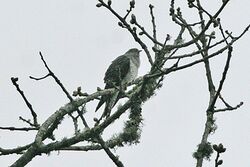Biology:Lesser cuckoo
| Lesser cuckoo | |
|---|---|

| |
| File:Hototogisu 07b8051.ogg | |
| Song recorded in Japan | |
| Scientific classification | |
| Domain: | Eukaryota |
| Kingdom: | Animalia |
| Phylum: | Chordata |
| Class: | Aves |
| Order: | Cuculiformes |
| Family: | Cuculidae |
| Genus: | Cuculus |
| Species: | C. poliocephalus
|
| Binomial name | |
| Cuculus poliocephalus Latham, 1790
| |
The lesser cuckoo (Cuculus poliocephalus) is a species of cuckoo in the family Cuculidae.
It is found in Bangladesh, Bhutan, China , Democratic Republic of the Congo, Hong Kong, India , Japan , Kenya, North Korea, South Korea , Laos, Malawi, Myanmar, Nepal, Pakistan , Russia, Seychelles, Somalia, South Africa , Sri Lanka, Tanzania, Thailand, Vietnam, Zambia, and Zimbabwe.
In culture
thumb|150px|left|Lesser cuckoo on a 1971 Japanese stamp In Japan, the bird is called Lua error in Module:Lang/utilities at line 268: attempt to call field '_transl' (a nil value). and frequently praised for its song.
It has been celebrated by numerous waka poets since the anthology Kokin wakashū (920).[2] Sei Shōnagon in her essay The Pillow Book (1002) mentions a trip she and other courtiers mounted on just to hear this bird, and it was expected of them that they would compose poetry on the occasion.[3] It is also the central image in poem 81 by Tokudaiji Sanesada in the anthology of 100 poems, the Hyakunin Isshu .[4]
The Japanese haiku magazine Hototogisu takes its name from the bird,[5] and the magazine's mastermind Masaoka Shiki's adopted pen name, Shiki (子規) also refers to the lesser cuckoo;[6] shiki corresponds to the Chinese zǐguī (子規), which is an alias for its standard name dùjuān (杜鵑).[7]
In Chinese dùjuān is a generic name and the species' common name is xiāodùjuān (小杜鵑).[7]
In Korean literature, the song of the lesser cuckoo represents the sound of sadness.[citation needed]
References
- ↑ BirdLife International (2016). "Cuculus poliocephalus". IUCN Red List of Threatened Species 2016: e.T22683889A93005868. doi:10.2305/IUCN.UK.2016-3.RLTS.T22683889A93005868.en. https://www.iucnredlist.org/species/22683889/93005868. Retrieved 13 November 2021.
- ↑ Keene, Donald (1999), Travelers of a Hundred Ages, Columbia University Press, p. 429, ISBN 9780231114370, https://books.google.com/books?id=iwxFsYEssv8C&pg=PA429
- ↑ Sei Shōnagon (1991), "65 It Was during the Abstinence of the Fifth Month", The Pillow Book of Sei Shōnagon, Columbia University Press, pp. 118–125, ISBN 9780231073370, https://books.google.com/books?id=H-F5iZeCMfQC&pg=PA118
- ↑ Porter, William N. (1979), "81 The Minister-of-the-Left of the Tokudai Temple", A Hundred Verses from Old Japan (The Hyakunin-isshu), Library of Alexandria, p. 81, ISBN 9781465579430, https://books.google.com/books?id=5dgRUlvV8nIC&pg=PA81
- ↑ Higginson, William J. (1985). The Haiku Handbook: How to Write, Share, and Teach Haiku. Tokyo: Kodansha International (published 1989). pp. 27. "While editing Hototogisu ('cuckoo'), the magazine founded under Shiki's guidance, Takahama Kyoshi (1874-1959) had devoted..."
- ↑ Sato, Hiroaki (2014), Japanese Women Poets: An Anthology: An Anthology, Routledge, p. 381, ISBN 9781317466963, https://books.google.com/books?id=gVffBQAAQBAJ&pg=PT381
- ↑ 7.0 7.1 "Zhongyao bieming sucha dacidian". Zhongyao bieming sucha dacidian. 学苑出版社. 1997. p. 315. ISBN 9787507710236. https://books.google.com/books?id=mLIcAQAAMAAJ. (in Chinese)
Wikidata ☰ Q495144 entry
 |


